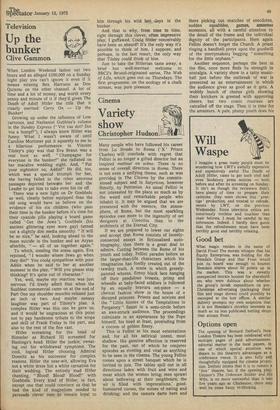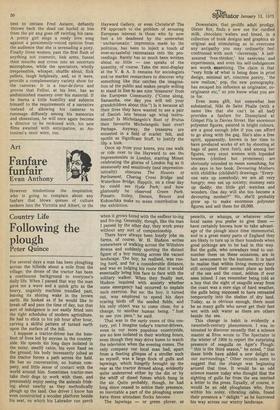Cinema
Variety show
Christopher Hudson
Many people who have followed his career from La Strada to Roma (' X ' Prince Charles) will conclude with regret that Fellini is no longer a gifted director but an inspired metteur en scene. There is no sense of overall direction in Roma. There is not even a unifying theme, such as was provided in The Clowns by the commissioned subject and in Satyricon, however flimsily, by Petronius. As usual Fellini is not interested by the place so much as by the weird and remarkable people who inhabit it. It may be argued that we are presented with the essence, the atmosphere, of Rome, but the most sparkling episodes owe more to the ingenuity of set designers at Cinecitta than to the architects of the Eternal City.
If we are prepared to lower our sights and accept that Roma consists of looselyconnected essays in fictionalised autobiography, then there is a great deal to admire. Cutting between the Rome of his youth and today, Fellini parades before us the larger-than-life characters which his imagination has fondly created out of the tawdry truth. A scene in which grosslypainted whores, flimsy black lace hanging off their pendulous breasts, primp and wheedle at baby-faced soldiers is followed by an equally bravura set-piece — a clerical fashion show in the house of a decayed princess. Priests and novices and the " Little Sisters of the Temptations in Purgatory" flaunt in a semi-circle before an awe-struck audience. The proceedings culminate in an appearance by the Pope himself, his head at least, protruding from a cocoon of golden finery.
This is Fellini at his most ostentatious and, for all his satirical intent, most shallow. His genuine affection is reserved for the past, out of which he conjures episodes as riveting and vital as anything to be seen in the cinema. The young Fellini comes upon a street banquet which he is invited to join. The tables spill out in all directions laden with fruit and wine and meat which the women bring; men sprawl about bellowing at their neighbours; the air is filled with imprecations, goodhumoured curses, the noises of eating and drinking; and the camera darts here and there picking out snatches of anecdotes, sudden squabbles, games, amorous moments, all with a careful attention to the detail of the frame and the individual dignity of the participants. Here again Fellini doesn't forget the Church. A priest ringing a handbell preys upon the goodwill of the merrymakers begging " something for the little orphans."
Another sequence, perhaps the best in the film, once more finds its strength in nostalgia. A variety show in a tatty musichall just before the outbreak of war is presented as an entertainment in which the audience gives as good as it gets. A wobbly bunch of chorus girls showing their knickers is greeted with approving cheers, but two comic routines are catcalled off the stage. Then it is time for the amateurs. A pale, plump youth does his best to imitate Fred Astaire, defiantly throws back the dead cat hurled at him from the pit and goes off twirling his cane. A pretty girl sings a reedy love song against a persistently-voiced opinion from the audience that she is serenading a pony. Finally three women, past the first flush of anything not cosmetic, link arms, funnel their mouths and croon into an uncertain microphone, while the spectators, wholly irrepressible, whisper, shuffle about, flick pellets, laugh helplessly, and, as it were, provide a complementary variety show for the cameras. It is a tour-de-force and proves that Fellini, at his best, has an undiminished mastery over his material. If he learns a little humility and subjects himself to the requirements of a narrative instead of allowing his cameras to rummage diffusely among his memories and obsessions, he will once again become a director to be reckoned with, his new films awaited with anticipation, as Antonioni's once were, too. Hayward Gallery, or even Christie's? The PR approach to the problem of arousing European interest in those who by now feel a bit deadened by the somewhat ' uncharismatic ' impression made by the politicos, has been to inject a touch of ever-so-tasteful razzmatazz •into the proceedings. Rarely has so much been written about so little — one speaks of the quantity, of course. Take •the mini-display at the V. & A. It remains for sociologists and/or market researchers to discover why something like this catches the imagination of the public and makes people willing to stand in line to see nine 'treasures' from the European Community. ("Come along, Samantha, one day you will tell your grandchildren about this.") Is it because all their lives they have wanted to see a pair of Danish late bronze age wind instruments? Is Michelangelo's Bust of Brutus their favourite Michelangelo bust ever? Perhaps. Anyway, the treasures are mounted in a field of scarlet felt, and spotlit as Significant Stuff, to justify the 10p a look.
Once up from your knees, you can walk or ride over to the Hayward to see the Impressionists in London, starring Monet celebrating the glories of London fog as it sensuously and sensitively (and impressionistically) obscures The Houses of Parliament, Charing Cross Bridge and Wateri000 Bridge. Happily, on a clear day he could see Hyde Park; and how gloriously he observed Green Park. Pissaro, Sisley, Derain, Renoir and Kokoschka make no mean contribution to the exhibition. Downstairs, that prolific adult prodigy, Dieter Rot, finds a new use for curdled milk, chocolate wafers and bread, in a collection of book designs and graphics so original and stimulating as to overcome any antipathy you may ordinarily feel confronted with such 'cleverness.' A selfassured 'free-thinker,' his exercises and experiments, and even his self-indulgences are worth examining. The claim is that "very little of what is being done in print design, minimal art, concrete poetry, 'the new realism,' pop, the new pornography, has escaped his influence as originator, cooriginator etc," so you know what you are in for.
Even more glib, but somewhat less substantial, Niki de Saint Phalle (with a name like that she can't be all bad) provides a fanfare for Disneyland at Gimpel Fils in Davies Street. Her enormous polyester figures, painted in bright colours, are a good enough joke if you can afford to go along with the gag. She's also a free spirit, apparently, known in her time to have produced works of art by shooting at bags of paint (wot fun!), and among her figures, very stout women with lopsided bosoms (clothed but prominent) are obviously intended to mean something, for she says in her book, Devouring Mothers, with childlike (childish?) drawings: "Everyone eats up somebody; we are all very hungry; men eat up society; mummy eats up daddy; the little girl watches and wonders. One day will she too become a devouring mother?" No, she'll probably grow up to make enormous polyester figures and sell them for £8,000.



































 Previous page
Previous page